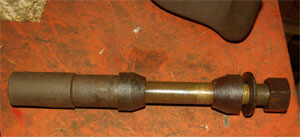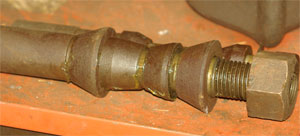


|

|
Mandrels are among the things that are in a machinist's bag of tricks for using a lathe. In order to turn something in a lathe you first have to get ahold of it. Faceplates, chucks and mandrels are the common solutions. Each has its place depending on what you need to hold. You start to think of mounting something on a mandrel if it has a hole through the middle of it (as in a piece of pipe or tubing. Likewise if you want to work all over the outside of it, clamping in a chuck may not work because the jaws will keep you from accessing one end of it.
Typical of the type of thing you might make on a mandrel such as those in the photograph is a bushing. First you would chuck the bushing up and drill/bore the inside of the bushing to the size needed. Then you want to turn the outside to be parallel with the inside. by clamping it on a mandrel such as those shown in the photos you can get it straight and true to the center hole and gain access to the full length of the bushing to turn the outside to size. The mandrel itself would be mounted in the lathe not by chucking it, but by putting it on centers on both ends, and using a dog to turn the mandrel. The mandrel's shown in the photo are old ones off the shelf and of course would need to be cleaned up a bit before they were used, but part of having a shop around for a long time is that you accumulate 'good things' like this which sit on the shelf just in case you might need them again. As you can see from the larger mandrel---it has been recycled at least once as it has an extra set of 'plugs' with it. Once you have the basic mandrel shaft made, you can often readapt it for a different job simply by making some new plugs, or by adding nor removing some spacers to accommodate different lengths or diameters.